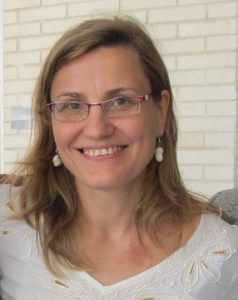GVN Center and Member Spotlight

Dr. Natàlia Majó
Director
Research Center on Animal Health (Centre de Recerca enSanitat Animal-CReSA)
Institute of Agrifood Research and Technology (Institut de Recerca i Tecnologia Agrolimentaria (IRTA)
Barcelona, Spain
What are you and your institution currently working on regarding COVID-19?
IRTA-CReSA is currently involved in studies related to repurposing antiviral testing against SARS-CoV-2, both in vitro and in vivo. Moreover, we are also involved in vaccine development, mainly on the side of animal model development. We already have a hamster model in place and, so far, we have demonstrated the protection of hamsters from SARS-CoV-2 re-infection. We also developed a pig model for immunogenicity studies. In addition, we are carrying out studies on SARS-CoV-2 disinfection devices and product efficiency.
Please describe your research on diagnostics, in vitro/in-vivo animal model vaccines, and cross-reactivity studies.
We have been working with zoonotic coronaviruses since 2014. We started first with MERS-CoV, in which we developed animal models of infection with dromedary camels, alpacas and llamas. We have also used these models to study immunopathogenesis of the infection in camelids (alpaca) and to test vaccines against MERS-CoV (dromedaries and llamas). So far, we have animal samples, including tissues and sera from vaccinated, experimentally infected animals. Therefore, we are in position of testing potential cross-reactivity between MERS-CoV and SARS-CoV-2.
Biosketch
I am veterinary pathologist, current Head of the Research Center on Animal Health (CReSA) -IRTA) and professor at the Veterinary School of the Universitat Autònoma de Barcelona.
My main areas of work, both in teaching and research, are focused on animal pathology and, more specifically, on avian pathology. For more than 15 years, I have been the leader of a research group focused on important avian viral diseases such as avian influenza. Our main contribution has been in understanding the pathogenetic mechanisms of this viral infection in different avian species, not only in commercial poultry species but also in wild birds. We have also focused on other economically important viral infections of poultry, as avian infectious bronchitis, infectious bursal disease or transmissible viral proventriculitis, carrying out studies on the detection and characterization of viral strains circulating in farms.
In addition, I have been member of the European College of Veterinary Pathologists (ECVP) Council and the Executive Committee of the Spanish Association of Poultry Science (AECA-WPSA). I have also been coordinating the Erasmus Mundus International Master in Infectious Diseases and One Health and I am currently an Associate Editor of the internationally recognized journal Avian Pathology.
Overview of CReSA-IRTA
The Centre de Recerca en Sanitat Animal (CReSA) is the animal health research program of the Institut de Recerca i Tecnologia Agroalimentàries (IRTA), a public company of the Autonomous Government of Catalonia (Spain). CReSA is located at the campus of the Universitat Autònoma de Barcelona (UAB), working in a new and technologically advanced building with conventional laboratories as well as biocontainment with level-3 biosecurity (BSL3) laboratories and animal facilities. The mission of CReSA is to contribute to the advancement of scientific and technical knowledge on animal health by means of research, knowledge transfer and services to public and private bodies. The long-term objective is to globally improve all aspects of animal health that influence the agri-food sector and public health. CReSA researchers’ expertise includes pathology, immunology, bacteriology, virology, entomology, epidemiology and molecular biology, as well as disease animal models. Viral research is focused on endemic and exotic viruses affecting mainly livestock (swine, ruminants and poultry) and occasionally wildlife. Zoonotic viruses including animal influenza viruses, West Nile virus, Rift Valley fever virus and MERS-coronavirus are nowadays significant poles of research.
